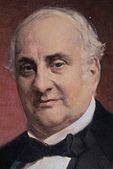20 January–15 February 1876 1879 → 1874 1872 3 seats 7 seats | Registered 3,604,000–3,989,612 1872 Unknown Start date January 20, 1876 | |
 | ||
Turnout 2,189,008–2,300,000 (54.9–63.8%) Winner Antonio Cánovas | ||
The 1876 Spanish general election was held from Thursday, 20 January to Tuesday, 15 February 1876, to elect the Constituent Restoration Cortes of the Kingdom of Spain. All 391 seats in the Congress of Deputies were up for election, as well as all 196 seats in the Senate.
Contents
This was the first election held after the end of the First Spanish Republic in 1874. The newly-founded Liberal Conservative Party (PLC) of Antonio Cánovas del Castillo won an overall majority of seats. The result of the election would pave the way for the adoption of the Spanish Constitution of 1876, marking the starting point of the Bourbon Restoration that would last until 1931.
Overview
The Spanish legislature, the Cortes, was composed of two chambers at the time of the 1876 election:
This was a nearly perfect bicameral system, with the two chambers established as "co-legislative bodies". Both chambers had legislative, control and budgetary functions, sharing equal powers except for laws on contributions or public credit, where the Congress had preeminence.
Electoral system
For the 1876 election, the laws of the First Spanish Republic remained in force, including the provisions for both the Congress and Senate within the Spanish Constitution of 1869. As a result, the original electoral law of 1870 was applied, without including changes made by the 1873 amendments.
For the Congress of Deputies, Spanish provinces were divided into 391 single-member districts, each electing one candidate under a single round of voting and a first-past-the-post system. Candidates winning a plurality of votes in each constituency were elected. The overall number of seats determined by the population count, with one seat per each 40,000 inhabitants. Voting was on the basis of universal manhood suffrage, with all males over twenty-one entitled to vote. Concurrently, every male at least twenty-one years old and in the full enjoyment of all civil rights was eligible for the Congress.
The Senate was not a directly elected body, with its 196 members—4 per province—elected by delegate vote. Delegates were appointed by local councils by universal suffrage. Senators served terms of twelve years each, with their terms staggered so that approximately one-quarter of these seats were up for appointment every three years. The King could dissolve the entire the Senate at will, triggering the appointment of all senators. Only nationals over forty who had held a public office of relevance or were major contributors to the province were eligible for the Senate.
Background
The pronunciamiento—a military coup—of Arsenio Martínez Campos on 29 December 1874 put an end to the First Spanish Republic and hastened the restoration of the Bourbon monarchy in the figure of Alfonso XII, son of former Queen Isabel II. An interim government led by Cánovas del Castillo was confirmed by King Alfonso XII upon disembarking in Barcelona on 9 January 1875.
